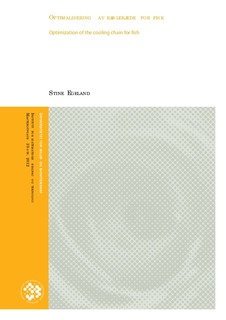| dc.contributor.advisor | Lekang, Odd-Ivar | |
| dc.contributor.author | Egeland, Stine | |
| dc.date.accessioned | 2012-09-03T11:58:15Z | |
| dc.date.issued | 2012-09-03 | |
| dc.identifier.uri | http://hdl.handle.net/11250/189241 | |
| dc.description.abstract | Formålet med denne oppgåva var å dokumentere kjølekjeda for tørrdistribusjon av fisk med
utgangspunkt i kjølekjeda til SALMA, og vurdere om kjølekjeda var optimal. Det blei nytta to ulike kjølemedium, gelice og tørris, samt ein kombinasjon av dei to. Effekten av superkjøling skulle også undersøkjast. Kjølekjeda blei dokumentert ved bruk av temperatursensorar som følgde fiskekassane frå slakteri til butikk. Eit lengre lagringsforsøk blei også gjennomført for å undersøkje temperaturutvikling i kassane over tid, og dermed evna kjølemedia hadde til å kjøle fisken.
Kjølekjeda i butikk blei også undersøkt ved same type temperatursensorar. 15 butikkar i
Osloområdet blei undersøkt, der temperatur i kjøledisk i sju av butikkane blei undersøkt over ein tidsperiode på ei veke. Rutinar rundt mottak og kjøling av fisk i butikk blei også undersøkt.
Resultata viste at gelice gav dårleg nedkjøling av fisken, og at temperaturkravet for kjøling av lett bedervelege matvarer i Forskrift for næringsmiddelhygiene ved bruk av gelice åleine var brote. Ved bruk av tørris eller kombinasjonen av gelice og tørris var kjølinga under dei gitte betingelsane innanfor forskriftskravet. Superkjøling av SALMA viste ikkje signifikante forskjellar i drypptap og kvalitetsindeks (QIM) ved samanlikning av kjølemedium. Unntaket var signifikant forskjell i drypptap mellom filetane kjølt med gelice og kombinasjonen gelice tørris. Resultata viste auka mikrobiell vekst ved kjøling med tørris samanlikna med gelice åleine, eller kombinasjonen gelice og tørris. Resultata frå forsøket er svekka som følgje av at ulik total kjølekapasitet for kjølemedia blei nytta, og at kjølinga derfor ikkje direkte kan samanliknast.
Oppgåva har vist at kjølekjeda i butikk dagleg blir broten, og at det i stor grad er rom for
forbetring av rutinar rundt kjøling og avriming av kjølediskar. Rutinar for handsaming av fisk i butikkane er også variable, og eit generelt auka kunnskapsnivå om kvalitet, handtering og kvalitetspåverkande aspekt rundt sjømat vil vere fordelaktig for konsumentane. | no_NO |
| dc.description.abstract | The purpose of the thesis was to document the cooling chain for dry distribution of fish, based on the cooling chain for SALMA, and consider whether the cooling chain was optimal or not. For cooling purposes were it used two different refrigerants, gelice and dry ice, and a combination of the two. The effect of super-cooling was also examined. The cooling chain was documented by the use of temperature sensors that followed the transportation boxes from the slaughterhouse to the vendor. A longer storage experiment was also conducted to examine the temperature development in the boxes over time, thereby the ability he cooling the media had to cool the fish.
The cooling chain in food stores was also examined with the same type of temperature sensors as used in the cooling chain documentation from slaughterhouse to the vendor. 15 shops in the Oslo area were studied, and the temperatures of the cooling disk in seven of the stores were documented over a period of one week. Routines around receiving and cooling of the fish in the shops were also documented.
The results showed that gelice gave poor refrigeration of fish, and the requirement stated in Forskrift for næringsmiddelhygiene with the use of gelice alone was broken. When using dry ice or the combination of gelice and dry ice, under the given conditions met the regulatory requirements. Super-cooling of SALMA showed no significant differences in drip loss, and quality index (QIM) when comparing the cooling method. The exception was a significant difference in drip loss from fillets chilled with gelice and the combination gelice dry ice. The results showed increased microbial growth by cooling with dry ice compared with gelice alone or the combination gelice and dry ice. There were an increased microbial growth in the fish cooled with dry ice compared with gelice and dry ice alone. The results of the experiment are weakened by the fact that different cooling capacity for the used cooling media were used, therefore the results are not directly comparable.
The thesis has shown that the cooling chain is broken in food stores daily, and there is room for improvement of procedures around the cooling and defrosting of cooling disks. Routines in the stores are also variable, and an increased level of knowledge will be beneficial to the consumers. | |
| dc.language.iso | nno | no_NO |
| dc.publisher | Norwegian University of Life Sciences, Ås | |
| dc.subject | Fishery products | no_NO |
| dc.subject | Salmon | no_NO |
| dc.subject | Food handling | no_NO |
| dc.subject | Cooling | no_NO |
| dc.subject | Cold storage | no_NO |
| dc.title | Optimalisering av kjølekjede for fisk | no_NO |
| dc.type | Master thesis | no_NO |
| dc.subject.nsi | VDP::Technology: 500::Food science and technology: 600 | no_NO |
| dc.description.embargo | 2017-05-15 | |
| dc.description.localcode | M-BA | |
